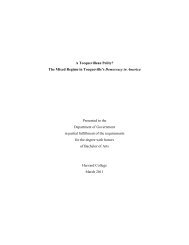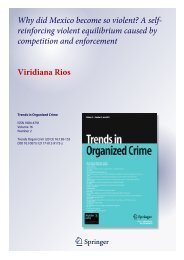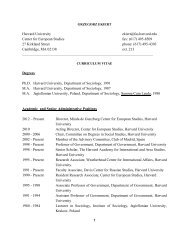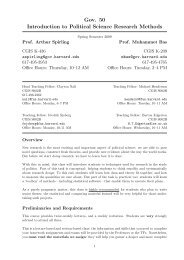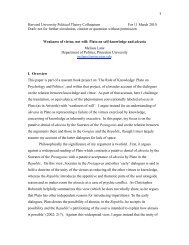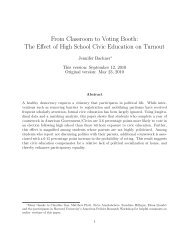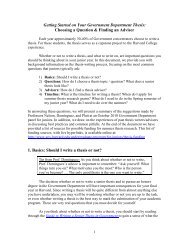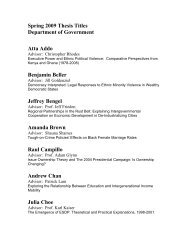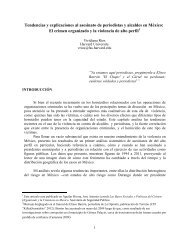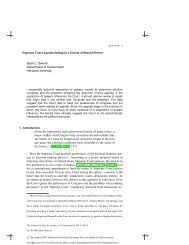Security issues and immigration flows: Drug-violence refugees, the ...
Security issues and immigration flows: Drug-violence refugees, the ...
Security issues and immigration flows: Drug-violence refugees, the ...
Create successful ePaper yourself
Turn your PDF publications into a flip-book with our unique Google optimized e-Paper software.
<strong>Security</strong> <strong>issues</strong> <strong>and</strong> <strong>immigration</strong> <strong>flows</strong>: <strong>Drug</strong>-<strong>violence</strong><br />
<strong>refugees</strong>, <strong>the</strong> new Mexican immigrants ∗<br />
Viridiana Rios<br />
November 16, 2011<br />
Abstract<br />
Mexican <strong>immigration</strong> figures have reached its lowest point since 2000. Yet,<br />
even if as a whole <strong>the</strong> US is receiving less Mexican migrants, <strong>the</strong> opposite is true<br />
for cities at <strong>the</strong> border. In this paper, I present evidence to show that this sui<br />
generis migration pattern cannot be understood only using traditional explanations<br />
of migration dynamics. Instead, Mexicans are migrating because of security <strong>issues</strong>,<br />
fearing drug-related <strong>violence</strong> <strong>and</strong> extortion, which has spiked since 2008. I estimate<br />
that a total of 264,693 have migrated fearing organized crime activities. By doing so,<br />
I combine <strong>the</strong> literature of migration dynamics with <strong>the</strong> one of <strong>violence</strong> <strong>and</strong> crime<br />
in Latin America, pointing towards ways in which non-state actors shape actions of<br />
state members.<br />
∗ Paper presented at Violence, <strong>Drug</strong>s <strong>and</strong> Governance: Mexican <strong>Security</strong> in Comparative Perspective<br />
Conference, Stanford University. October 3-4, 2011 (Palo Alto, CA)<br />
1
“Why are we in Mexico?,” I asked my research fellow<br />
after falling sleep during our border road trip.<br />
“We are in Texas,” he answered.<br />
Mexican <strong>immigration</strong> to <strong>the</strong> US has diminished steadily since 2000. With figures dropping<br />
from an estimated of 525 thous<strong>and</strong> Mexicans yearly leaving <strong>the</strong>ir country to establish at<br />
<strong>the</strong> US to fewer than 100 thous<strong>and</strong>, current migration figures are <strong>the</strong> lowest on record<br />
(Sheridan, 2011; Cave, 2011). Among <strong>the</strong> main reasons behind this diminishing trend<br />
are changes in Mexico’s demographic profile (Terrazas et al, 2011), an increase in <strong>the</strong><br />
number of Mexicans earning college degrees (Ibarraran <strong>and</strong> Lubotsky, 2007; Orrenius<br />
<strong>and</strong> Zavodny, 2005), a constant increase in <strong>the</strong> costs associated with crossing <strong>the</strong> border<br />
(Massey <strong>and</strong> Dur<strong>and</strong> 2003; Orrenius 2004; Wayne <strong>and</strong> Lewis 2006; MPP, 2009), <strong>and</strong> <strong>the</strong><br />
recession that <strong>the</strong> US economy has been facing since late 2007 (Papademetriou et al, 2011).<br />
Even if <strong>the</strong> US as a whole has experienced a decrease in <strong>the</strong> number of Mexican<br />
immigrants, <strong>the</strong> opposite seems to be true for US cities located at <strong>the</strong> border. Mexican<br />
<strong>immigration</strong> to El Paso, McAllen, Brownsville <strong>and</strong> o<strong>the</strong>r cities in Texas have actually<br />
increased, increasing <strong>the</strong> price of housing <strong>and</strong> promoting <strong>the</strong> development of br<strong>and</strong> new<br />
housing complexes targeted towards Mexican consumers. Only preliminary figures are<br />
available on <strong>the</strong> size of this migration but <strong>the</strong> preliminary reports estimate about 115,000<br />
Mexicans have arrived US border cities since 2006 (IDCM, 2010; Rice, 2011). El Paso, for<br />
example, has grown by 50,000 inhabitants from 2009 to 2011, <strong>and</strong> at least 30,000 of <strong>the</strong>se<br />
new inhabitants are Mexicans moving from Ciudad Juarez (Rubio Salas interviewed by<br />
Alvarado, 2011).<br />
Fur<strong>the</strong>rmore, <strong>the</strong>se new Mexican immigrants have little in common with <strong>the</strong> traditional<br />
Mexican immigrants. At border cities, it has become more <strong>and</strong> more common<br />
to see Mexicans wearing Prada <strong>and</strong> driving Mercedes. They cross into Mexico to work<br />
<strong>and</strong> come back to <strong>the</strong> US to sleep <strong>and</strong> spend <strong>the</strong>ir weekends in <strong>the</strong>ir newly constructed<br />
gated communities (citizen interviews by Rios, 2008). The new Mexicans are investors<br />
<strong>and</strong> relatively wealthy businessman that used to live at Mexican border cities <strong>and</strong> have<br />
2
ecently changed <strong>the</strong>ir residency to <strong>the</strong> US. They get into <strong>the</strong> US legally, buy property<br />
<strong>and</strong> open businesses (Martinez, 2011).<br />
In order to underst<strong>and</strong> <strong>the</strong>se phenomenon, I bring toge<strong>the</strong>r one of <strong>the</strong> most important<br />
strings of Latin American academic research, <strong>the</strong> examination of migration <strong>flows</strong><br />
(Hellman, 2011), <strong>and</strong> what is considered <strong>the</strong> upcoming research topic of <strong>the</strong> region: studies<br />
of crime, security <strong>and</strong> <strong>violence</strong> (Di Tella, Edwards <strong>and</strong> Schargrodsky 2010). It is my<br />
claim that to fully underst<strong>and</strong> migration dynamics from Mexico to <strong>the</strong> US, <strong>and</strong> within<br />
Mexico, we need to broaden our analysis of <strong>the</strong> factors that we normally analyze as part<br />
of traditional <strong>immigration</strong> literature –such as economic hardship, network analysis, or<br />
labor dynamics– to include <strong>the</strong> impact that non-state-actors behaviour –such as <strong>violence</strong><br />
caused by criminal organizations– is having on migration <strong>flows</strong>. In particular, I argue that<br />
drug-related <strong>violence</strong> <strong>and</strong> organized crime activities are affecting migration dynamics in<br />
Mexico. A importan share of Mexicans are relocating to <strong>the</strong> US, <strong>and</strong> to o<strong>the</strong>r cities within<br />
<strong>the</strong>ir country, running away from drug-related homicides <strong>and</strong> criminal activity which has<br />
spiked since 2008.<br />
In making this argument, I speak to broader political science <strong>the</strong>ories of <strong>the</strong> impact<br />
that non-state actors may have on shaping decisions taken by state members, as well as<br />
on <strong>the</strong> way in which non-state actors can fundamentally change <strong>the</strong> allocation of human<br />
capital <strong>and</strong> resources within a polity, or from one polity to ano<strong>the</strong>r. Fur<strong>the</strong>rmore, <strong>the</strong><br />
same logic used within this piece can be used to underst<strong>and</strong> o<strong>the</strong>r research agendas such<br />
as <strong>the</strong> ”white flee” <strong>and</strong> o<strong>the</strong>r forms of migration caused by neighborhood effects (Wilson<br />
1997, Cullen <strong>and</strong> Levitt 1999, Olive <strong>and</strong> Shapiro 2006), <strong>and</strong> way in which state capacity<br />
ultimately affects <strong>the</strong> relationship between <strong>the</strong> state <strong>and</strong> criminal organizations (Bailey<br />
<strong>and</strong> Godson 2000, Williams 2002).<br />
This paper is organized in five sections. The first presents an overview of Mexico’s<br />
security situation with a particular emphasis on a very recent phenomenon: an abrupt<br />
increase in <strong>the</strong> number of homicides related to drug trafficking activities, <strong>and</strong> o<strong>the</strong>r ac-<br />
3
tivities related to organized crime such as kidnappings <strong>and</strong> extortions. A second section<br />
explores migration <strong>flows</strong> at <strong>the</strong> border <strong>and</strong> within Mexico, <strong>and</strong> shows why Mexicans living<br />
at border towns seem to be particularly sensitive towards migrating. The third <strong>and</strong><br />
fourth sections show my statistical specifications <strong>and</strong> results. I estimate that a total of<br />
264,693 Mexicans have changed residency in direct response to drug-related homicides. A<br />
fifth section provides qualitative evidence of migration <strong>flows</strong> driven by security concerns,<br />
ra<strong>the</strong>r than by economic hardship, <strong>and</strong> describes some particularly interesting cases that<br />
support my quantitative findings.<br />
Mexico’s drug-related <strong>violence</strong><br />
“Fear has become part of our lives () There’s panic. We<br />
don’t know when <strong>the</strong> shooting is going to break out”<br />
—Tijuana citizen 1<br />
Mexico’s homicide rates have increased every year since 2004 –particularly sharply<br />
since 2008– as a result of increases in territorial fights between drug cartels. From December<br />
of 2006 to 2010, 34,550 killings have been officially linked to organized crime, a<br />
dramatic increase from previous years (2000 2006) when only 8,901 killings were linked to<br />
organized crime. The major increase <strong>violence</strong> spike of 2008 came when drug-related homicides<br />
jumped from 2,826 to 6,837 killings, a 142% increase with respect to <strong>the</strong> previous<br />
year. After ano<strong>the</strong>r increase of more than 40%, homicides reached 9,614 victims in 2009,<br />
<strong>and</strong> <strong>the</strong> record figure of 15,273 by 2010. In this last year, organized crime was officially<br />
responsible for 47% of all intended homicides happening in Mexico (Rios <strong>and</strong> Shirk, 2011).<br />
Mexico’s security <strong>issues</strong> are particularly acute at <strong>the</strong> border. Most drug-related<br />
homicides concentrate at border cities because US-Mexico crossing points are where <strong>the</strong><br />
1 Lacey (2008); Tijuana is a border town located south of San Diego, CA; during 2008, it saw 614 drugrelated<br />
homicides, a rate of about 43.72 per 100,000 inhabitants — quite larger than not-drug-related<br />
homicides, which cause only 20.46 casualties per 100,0000.<br />
4
most profitable part of drug trafficking business chain occurs (See Figure 1). When a<br />
kilogram of cocaine crosses into <strong>the</strong> US, its value increases from $ 6,000—10,000 to up<br />
to $ 19,000 (DEA cited by Brouwer et al, 2006). Mexican border towns are <strong>the</strong> centers<br />
of operation of most Mexican drug cartels. In fact, two of <strong>the</strong> most important criminal<br />
organizations in Mexico are named after border cities: <strong>the</strong> Tijuana Cartel, which operates<br />
mostly south of California, <strong>and</strong> <strong>the</strong> Juarez Cartel, which controls most <strong>the</strong> border located<br />
on west Texas. A third cartel, Gulf —named after <strong>the</strong> Gulf of Mexico— controls <strong>the</strong> east<br />
border crossings.<br />
[Figure 1 about here]<br />
The five Mexican states located at <strong>the</strong> border account for 47.81% of all drugrelated<br />
murders despite containing just 17.62% of all Mexico’s population. Chihuahua,<br />
south of Texas, is <strong>the</strong> most violent border state with 10,126 murders, followed by Baja<br />
California <strong>and</strong> Tamaulipas with 2,016 <strong>and</strong> 1,477 drug-related homicides respectively. The<br />
same pattern of <strong>violence</strong> spiking in areas in close proximity to <strong>the</strong> border is present at <strong>the</strong><br />
municipal level as well. Municipalities located near <strong>the</strong> US-Mexico border, particularly<br />
those containing large border cities, are among <strong>the</strong> most violent. Approximately 30.04%<br />
of all drug-related homicides occurred in 39 border municipalities, which represent less<br />
than one percent of <strong>the</strong> roughly 2,450 municipalities in Mexico, <strong>and</strong> just 6.06% of <strong>the</strong><br />
country’s population. The most violent city in Mexico is Juarez, south of El Paso, Texas,<br />
a relatively small city of about 1.31 million inhabitants in which 6,437 homicides have<br />
occurred from 2006 to 2010 (18.65% of <strong>the</strong> total national toll). To put this figure in<br />
perspective, Juarez exhibited drug-related homicide rates of 216.06 victims per 100,000<br />
inhabitants in 2010, a casualty rate that is comparable to that of war zones.<br />
<strong>Drug</strong>-related homicides within Mexico have not only increased but changed in<br />
nature. Unlike before, government authorities are increasingly targeted by traffickers<br />
(Freeman, 2006; CNDH, 2009). In border cities like Tijuana, south of California, at least<br />
100 policemen die on duty every year (Guerrero, 2009). To put this in perspective, in <strong>the</strong><br />
5
entire United States 133 police o?cers were killed in <strong>the</strong> line of duty in 2008. The chief of<br />
police in Nuevo Laredo, south of Texas, lasted eight hours in <strong>the</strong> position (Garza 2009)<br />
before been assassinated by traffickers. Traffickers have also created new ways to spread<br />
fear among <strong>the</strong> population. Bodies are left in <strong>the</strong> streets with messages towards o<strong>the</strong>r<br />
citizens, politicians or fellow criminals. Heinous acts such as decapitation <strong>and</strong> torture<br />
have become <strong>the</strong> norm ra<strong>the</strong>r that <strong>the</strong> outlier; heads are thrown into <strong>the</strong> doors of primary<br />
schools, <strong>and</strong> executions of many people have replaced targeted murders of a single person.<br />
Fur<strong>the</strong>rmore, criminal organizations have diversified <strong>the</strong>ir activities getting into<br />
alternative illegal businesses. Extortion is perhaps <strong>the</strong> most widespread of <strong>the</strong>se new<br />
criminal ventures. Criminals initially used extortion to target illegal business such as<br />
prostitution rings <strong>and</strong> casinos, industries in which <strong>the</strong> probability of being denounced to<br />
<strong>the</strong> police by <strong>the</strong> owner was exceedingly low. However, <strong>the</strong> extortion of businesses soon<br />
extended into <strong>the</strong> legal sphere <strong>and</strong> became <strong>the</strong> most accessible means of quickly acquiring<br />
cash for traffickers. It has deeply affected business dynamics. High protection fees<br />
<strong>and</strong> intimidation have forced businesses to go into bankruptcy <strong>and</strong> have pushed some<br />
businessman to take radical action such as creating violent organizations for self-defense.<br />
In fact, some businessmen in nor<strong>the</strong>rn Mexico claim to be part of an association called<br />
“The Zeta Killers”—referring to Zetas, a drug cartel well known for <strong>the</strong>ir participation<br />
in extortion <strong>and</strong> kidnapping. The Zeta Killers have taken credit for <strong>the</strong> assassination of<br />
hundreds of Zetas (citizen interviewed by Rios, 2008). The bodies of tortured traffickers<br />
regularly appear in cities around Mexico like Boca del Rio, Benito Juarez, <strong>and</strong> Celaya<br />
next to messages signed by this group, such as, “We are <strong>the</strong> new group of The Zeta Killers<br />
<strong>and</strong> we are against kidnapping <strong>and</strong> extortion, <strong>and</strong> we will fight against <strong>the</strong>m in all <strong>the</strong><br />
states for a cleaner Mexico (sic) (Sipse, 2009)”.<br />
Unexpected migration <strong>flows</strong> in Mexico<br />
“Those who can, leave, those who can’t, hide.”<br />
6
—Reynosa citizen 2<br />
Over <strong>the</strong> last couple years, some Mexican cities have started depopulating unexpectedly.<br />
As a result, <strong>the</strong> usual general predictors of population trends, which have<br />
previously been quite successful in predicting <strong>the</strong> yearly population in Mexican counties<br />
(Partida Bush, 2008) are producing higher than normal prediction errors. Cities like<br />
Praxedis de Guerrero, Mier <strong>and</strong> Guadalupe have faced expected unexpected out<strong>flows</strong> of<br />
more than 25% of <strong>the</strong>ir whole population (CONAPO, 2008; INEGI 2010).<br />
Unexpected migration out<strong>flows</strong> have been particularly prominent in areas located<br />
on <strong>the</strong> US-Mexico border, probably because acquiring U.S. residency is relatively easy<br />
<strong>the</strong>re (Table 1). While border cities tended to lose an average of 35,255 inhabitants unexpectedly,<br />
not border counties tended to gain an average of 1,297.86 inhabitants. The<br />
tendency is less strong when considering all border counties —independently on whe<strong>the</strong>r<br />
<strong>the</strong>se are or not cities— yet even so, on average about 8,103.63 people left unexpectedly<br />
in <strong>the</strong>se cases.<br />
[Table 1 about here]<br />
When considering all Mexican cities, among <strong>the</strong> ones experiencing <strong>the</strong> largest unexpected<br />
population out<strong>flows</strong> are important border cities. Juarez has lost 150.36 thous<strong>and</strong><br />
inhabitants–about 11% of its population. O<strong>the</strong>r cities with considerably high <strong>violence</strong><br />
levels like Tijuana, Reynosa, <strong>and</strong> Matamoros have lost between 6%, 9% <strong>and</strong> 4% of <strong>the</strong>ir<br />
population during <strong>the</strong> same period (CONAPO, 2008; INEGI, 2010) (Table 2).<br />
[Table 2 about here]<br />
It is impossible to know where <strong>the</strong>se people relocated but preliminary figures agree<br />
that at least half of <strong>the</strong>m moved to <strong>the</strong> US (IDMC, 2010; Rice, 2011). Particularly, for<br />
2 Interviewed by Author (2008); Reynosa is a Mexican border city located south of Texas with drugrelated<br />
homicide rates of about 26.18 per 100,000 inhabitants in 2010.<br />
7
middle <strong>and</strong> upper class Mexicans living on <strong>the</strong> border, migration to <strong>the</strong> US feels like <strong>the</strong><br />
natural choice if a change of residency is being planned. For many of <strong>the</strong>m it is just<br />
like moving from one neighborhood to ano<strong>the</strong>r within a same city, or as <strong>the</strong>y describe<br />
it, “moving to <strong>the</strong> American side of <strong>the</strong> city (citizen interviewed by Author, 2008).” Inhabitants<br />
commonly refer to border cities using <strong>the</strong>ir Mexican or American name almost<br />
interchangeably. As <strong>the</strong> mayor of Laredo said “we are inhabitants of Laredos” —referring<br />
to Laredo, Texas (USA) <strong>and</strong> Nuevo Laredo, Tamaulipas (Mexico)— “<strong>the</strong> border does not<br />
divide our policies or families (Garza interviewed by Author, 2009).”<br />
The integration of US <strong>and</strong> Mexican cities located right at <strong>the</strong> border is quite strong<br />
<strong>and</strong> rooted in historically important but informal agreements. Many border cities were<br />
divided artificially when <strong>the</strong> Rio Bravo was determined to be <strong>the</strong> natural frontier between<br />
Mexico <strong>and</strong> <strong>the</strong> US during <strong>the</strong> late XIX century (Garza interviewed by Author, 2008).<br />
The border divided families <strong>and</strong> communities, leading Mexican <strong>and</strong> American authorities<br />
to create informal mechanisms to facilitate transportation between border-city inhabitants.<br />
Many of <strong>the</strong>se have lasted over <strong>the</strong> years, generating a much more porous border<br />
than Washington <strong>and</strong> Mexico City seem to be willing to accept. Students at Juarez,<br />
for example, pay local tuition at <strong>the</strong> University of Texas at El Paso. Fur<strong>the</strong>rmore, border<br />
cities have instituted “day border passes,” a form of one-day-visa given to Mexican<br />
border inhabitants that allow <strong>the</strong>m to cross into <strong>the</strong> US without a formal visa or passport.<br />
O<strong>the</strong>r Mexicans have surely relocated within Mexico. Indeed, some cities, particularly<br />
Acapulco, Chimalhuacan <strong>and</strong> Tlajomulco have experienced unexpected migration<br />
in<strong>flows</strong> (Table 1). Tlajomulco for example, grew about 30% more than population predictions<br />
had accounted for, Juarez (Nuevo Leon) <strong>and</strong> Bahia de B<strong>and</strong>eras also grew in more<br />
than 18%.<br />
In <strong>the</strong> following section I present empirical evidence linking drug <strong>violence</strong> <strong>and</strong> organized<br />
crime activities to Mexican migration out<strong>flows</strong>. The results represent <strong>the</strong> first<br />
empirically-based <strong>the</strong>ory to argue that Mexico’s migration <strong>flows</strong> are being driven by se-<br />
8
curity concerns ra<strong>the</strong>r than by traditional economic variables.<br />
Empirical specifications<br />
As my main specification I used a linear regression model, with White-Huber corrected<br />
st<strong>and</strong>ard errors, whose dependent variable is <strong>the</strong> number of Mexicans unexpectedly leaving<br />
<strong>the</strong>ir county of residence from 2005 to 2010. All figures were scaled to represent rates<br />
per 100,000 inhabitants. To measure unexpected migration out<strong>flows</strong> I compare population<br />
predictions (CONAPO, 2008) to real population figures (INEGI, 2010) at each of <strong>the</strong> ∼<br />
2.5 thous<strong>and</strong> Mexican counties.<br />
This research project was made possible because of a mistake made by Mexico’s<br />
National Population Council (CONAPO). Every year, CONAPO predicts county-level<br />
population figures considering demographic changes <strong>and</strong> expected <strong>immigration</strong> out<strong>flows</strong>.<br />
Given how important migration out<strong>flows</strong> to <strong>the</strong> US are as predictors of population figures,<br />
CONAPO uses very sophisticated methods to predict <strong>the</strong> total number of Mexicans<br />
that will change <strong>the</strong>ir residency to <strong>the</strong> U.S. 3 The predictions take into account economic<br />
conditions both in Mexico <strong>and</strong> <strong>the</strong> U.S., surveys, polls, previous census figures, <strong>and</strong> panel<br />
studies. Every five years, when a census is conducted in Mexico, CONAPO predictions<br />
can <strong>the</strong>n be checked for accuracy. Their predictions are normally quite good. For <strong>the</strong><br />
2005 census, for example, <strong>the</strong> prediction had an error of just 686,478 thous<strong>and</strong> individuals,<br />
about 0.66% of <strong>the</strong> total population.<br />
In my main specification, I compare CONAPO predictions to census figures in<br />
2010 (last census year; INEGI, 2010) to capture population out<strong>flows</strong> that could not be<br />
predicted by changes in economic or demographic conditions. Unexpected out<strong>flows</strong> are<br />
3 Predictions are based in <strong>the</strong> algorithms developed by Bean et al (2001) <strong>and</strong> Corona <strong>and</strong> Tuiran (2006)<br />
using Mexican <strong>and</strong> US Census figures (1950 — 2005), <strong>the</strong> Current Population Survey (1990 — 2005) <strong>and</strong><br />
<strong>the</strong> American Community Survey (2002 — 2005). For more details on <strong>the</strong> specification see Partida Bush<br />
(2008).<br />
9
larger when CONAPO predicted more people will be living in a county than <strong>the</strong> census<br />
captured.<br />
In every specification, I added a control to account for o<strong>the</strong>r unmeasurable factors<br />
driving possible errors in CONAPO’s prediction. I proxied for “expected CONAPO’s<br />
errors” by measuring <strong>the</strong> error that CONAPO had in its previous predictions. I used <strong>the</strong><br />
estimation errors that CONAPO had in <strong>the</strong> second to last census year (INEGI, 2005)<br />
because time wise, I expect 2010 municipalities to be more similar to what <strong>the</strong>y were in<br />
2005 than to any o<strong>the</strong>r census year fur<strong>the</strong>r behind. The logic behind this proxy is to control<br />
for counties that have proven to be difficult to estimate for CONAPO. Some counties<br />
may have inherent characteristics that make <strong>the</strong>ir population figures more variable <strong>and</strong><br />
thus, highly susceptible to be incorrect estimation.<br />
As my independent variables, I used measures of three of <strong>the</strong> most common types<br />
of organized crime <strong>violence</strong> in Mexico: homicides linked to drug trafficking, extortion, <strong>and</strong><br />
kidnapping. These variables quantified as <strong>the</strong> total number of incidences of <strong>the</strong>se crimes<br />
per county, per 100,000 inhabitants for years in between census (i.e. 2006 to 2009).<br />
<strong>Drug</strong>-related homicides figures come from Mexico’s National <strong>Security</strong> Council (2011), an<br />
institutions that counts <strong>the</strong> number of homicides related to activities of criminal organizations<br />
<strong>and</strong> provides monthly figures per county since December of 2006 <strong>and</strong> until December<br />
of 2010 4 . Kidnapping <strong>and</strong> extortion figures were obtained from state-level Mexico’s offices<br />
of <strong>the</strong> general attorney (INEGI, 2009).<br />
To control for social <strong>and</strong> economic factors which may have generated unexpected<br />
economic conditions within Mexico (which could have changed migration patterns more<br />
than CONAPO could have predicted) I added two sets of controls: employment <strong>and</strong> education<br />
figures. Academic research indicates that <strong>the</strong>se two variables are among <strong>the</strong> most<br />
important drivers of migration (Massey, et al, 1998). Particularly, research shows that<br />
4 Mexican authorities follow strict procedures to identify whe<strong>the</strong>r a homicide is related to organized<br />
crime according to <strong>the</strong> characteristics of <strong>the</strong> event as well as intelligence reports. For more information,<br />
refer to STSP (2011).<br />
10
<strong>the</strong> number of college graduates is an important deterrent of migration to <strong>the</strong> US <strong>and</strong><br />
an enhancer of migration within Mexico, from rural to urban areas (MPP, 2009). Higher<br />
levels of employment normally translate into less migration (Tuiran, 2000a; Tuiran, 200b).<br />
A dummy for each of <strong>the</strong> 39 Mexican counties located right at <strong>the</strong> border was<br />
added. The intention is to capture, in a very indirect way, <strong>the</strong> easiness of migration decisions.<br />
The assumption is that any factor increasing migration willingness among Mexicans<br />
will have an increased effect on border counties, where migration costs are lower with respect<br />
to <strong>the</strong> rest of <strong>the</strong> country. An alternative specification also added a dummy for each<br />
of <strong>the</strong> 5 border states.<br />
Finally, as part of robustness tests, extra controls <strong>and</strong> specifications were tested.<br />
An alternative specification adds figures of general homicides not related to organized<br />
crime as assessed by INEGI (2009) to account for <strong>the</strong> effects that o<strong>the</strong>r forms of <strong>violence</strong><br />
may have had in driving migration. State fixed effects (32 clusters, one per Mexican state)<br />
were also added 5 .<br />
General descriptive statistics of <strong>the</strong> dependent <strong>and</strong> independent variables are presented<br />
in Table 3.<br />
[Table 3 about here]<br />
Principal Results<br />
The results of <strong>the</strong> model are given in Table 2, <strong>and</strong> <strong>the</strong>y strongly support my hypo<strong>the</strong>sis.<br />
Migration out<strong>flows</strong> are higher in places with higher drug-related <strong>violence</strong> <strong>and</strong> crime, even<br />
accounting for factors such as employment <strong>and</strong> human capital. Several models were spec-<br />
5 I tested for weighted coefficients based on <strong>the</strong> inverse of <strong>the</strong>ir squared residuals. The use of weights<br />
did not changed coefficients or st<strong>and</strong>ard errors meaningfully. Results available under request.<br />
11
ified.<br />
Model 1 present results without controlling for not-drug-related homicides while<br />
<strong>the</strong> rest of <strong>the</strong> specifications (Model 2 <strong>and</strong> 3) control for <strong>the</strong>m. Controlling for not-drugrelated<br />
homicides does not change <strong>the</strong> results but increases <strong>the</strong> goodness of fit of <strong>the</strong><br />
models. <strong>Drug</strong>-related <strong>violence</strong> is strongly linked to migration <strong>flows</strong>, independent of <strong>the</strong><br />
general homicide rate in a county. Fur<strong>the</strong>rmore, in every specification <strong>the</strong> coefficients<br />
of drug-related homicides are larger than those of general homicides which confirms my<br />
hypo<strong>the</strong>sis that Mexicans are taking migration decisions based in organized crime activities<br />
ra<strong>the</strong>r than in general security concerns. The reason why drug-related homicides<br />
are better predictors of migration <strong>flows</strong> than general homicides may be that drug-related<br />
homicides are a newer phenomena, not an important cause of homicides before 2004 (Rios<br />
<strong>and</strong> Shirk 2011), <strong>and</strong> leave a longer lasting impression in <strong>the</strong> communities because of <strong>the</strong>ir<br />
particularly violent features. Unlike general homicides, <strong>the</strong> victims of drug-related homicides<br />
are tortured <strong>and</strong> beheaded, <strong>and</strong> <strong>the</strong>ir bodies are dumped at <strong>the</strong> streets, hanged from<br />
pedestrian bridges, or displayed publicly next to messages directed to rivalry trafficking<br />
organizations.<br />
Model 3 adds fixed effects per states to capture changes happening at <strong>the</strong> state<br />
level that may have influenced migration dynamics —for example, we should expect citizens<br />
living in states with well publicly regarded justice systems to be less affected by<br />
drug-related <strong>violence</strong> even if <strong>the</strong> number of homicides are <strong>the</strong> same than in states where<br />
citizens are less confident of <strong>the</strong>ir governments.The goal of <strong>the</strong> paper is to show that out<strong>flows</strong><br />
are correlated with organized crime activities, which is why Model 3 is considered<br />
<strong>the</strong> preferred specification.<br />
[Table 4 about here]<br />
Indeed, in all specifications, drug-related homicides are an important factor in<br />
Mexican migration out<strong>flows</strong>. In my preferred specification (model 3), drug-related homi-<br />
12
cides increased <strong>the</strong> number of Mexicans unexpectedly migrating out of <strong>the</strong>ir residency<br />
counties by 220,291. Every one point increase in <strong>the</strong> rate drug-related homicides per<br />
100,000 inhabitants is correlated with 6.34 Mexicans fleeing <strong>the</strong>ir county of residency. As<br />
an example, consider <strong>the</strong> case of Tijuana; in <strong>the</strong> period from 2007 to 2008, its drug-related<br />
homicides rate changed by 31.04 points (going from 176 to 614 drug-related homicides in<br />
just one year). If <strong>the</strong> results of <strong>the</strong> model hold, an average of 5,367 Mexicans left Tijuana<br />
just during 2008 fleeing from drug-related homicides.<br />
<strong>Drug</strong>-related homicides are less robust predictors of unexpected <strong>immigration</strong> in<strong>flows</strong><br />
actually, when fixed effects per state are added, <strong>the</strong> variable becomes insignificant.<br />
That is to say, even if drug-related homicides are correlated with people leaving <strong>the</strong>ir<br />
counties, this does not mean that, when deciding on where to relocate, people will feel<br />
more attracted to counties with less drug-related homicides. Counties with higher drugrelated<br />
homicides expel people but counties with lower drug-related homicides do not<br />
attract people.<br />
O<strong>the</strong>r organized crime activities, particularly extortion also have had important<br />
effects in migration <strong>flows</strong>. Extortion is correlated with unexpected migration out<strong>flows</strong><br />
—<strong>and</strong> less robustly with unexpected migration in<strong>flows</strong>. In <strong>the</strong> preferred specification,<br />
every additional case of extortion per 100,000 inhabitants increases unexpected migration<br />
out<strong>flows</strong> in 13.03 per 100,000 inhabitants. That accounts for a total of 44,401 Mexicans<br />
relocating running out of extortion. Tijuana has lost about 926 citizens because of extortion;<br />
o<strong>the</strong>r border cities like Nuevo Laredo, Reynosa <strong>and</strong> Juarez had lost 286, 334 <strong>and</strong><br />
221, respectively. Kidnappings were not significantly correlated with migration out<strong>flows</strong><br />
or in<strong>flows</strong>. This result is quite robust among all models <strong>and</strong> is consistent with what we<br />
would expect given <strong>the</strong> particularities of <strong>the</strong> victims of this crime. Kidnapper pick <strong>the</strong>ir<br />
victims according to <strong>the</strong>ir wealth not by location. Because kidnapping victims are hunted,<br />
migration does not change <strong>the</strong>ir attractiveness as targets.<br />
Traditional, economic explanations of migration <strong>flows</strong> take <strong>the</strong> expected signs <strong>and</strong><br />
13
are significant in all out<strong>flows</strong> specifications. An increase of one point in employment rates<br />
or in <strong>the</strong> number of college degrees per 100,000 inhabitants reduces migration out<strong>flows</strong> in<br />
0.01 <strong>and</strong> 0.11 per 100,000 inhabitants, respectively. Nei<strong>the</strong>r employment, nor education<br />
are significantly correlated with migration in<strong>flows</strong>. In o<strong>the</strong>r words, when deciding where<br />
to relocate, Mexicans do not go to cities with higher levels of education or lower unemployment.<br />
Finally, all variables introduced to correct for CONAPO’s error were strongly significant.<br />
Indeed, it seems like CONAPO faces inherent problems in measuring population<br />
<strong>flows</strong> in some places more than o<strong>the</strong>rs. In general, places where CONAPO’s 2005 predictions<br />
were upward biased (i.e. CONAPO predicted more people than <strong>the</strong> 2005 census)<br />
had <strong>the</strong> same upper bias in 2010. The relationship is 1 to 0.77 in <strong>the</strong> preferred specification,<br />
meaning an error of 1 in 2005 figures is correlated with an error of 0.77 in 2010 figures 6<br />
The new driver of Mexico’s <strong>immigration</strong> <strong>flows</strong>: security<br />
<strong>issues</strong>.<br />
“I know that we came here illegally, but at least we can sleep in peace now”<br />
Citizen of Juarez relocated at El Paso (Torres, 2011)<br />
The effect of <strong>violence</strong> in determining migration out<strong>flows</strong> is a well-studied phenomenon<br />
within political science research of Africa <strong>and</strong> o<strong>the</strong>r civil-war contexts (Zolberg et al,<br />
1989; Morrison, 1993). Most of <strong>the</strong>se studies emphasize <strong>the</strong> role of <strong>violence</strong> in generating<br />
6 The fact that drug-related <strong>violence</strong> is predictor or unexpected migration out<strong>flows</strong> is a particularly<br />
robust finding even more, if we consider that CONAPO’s 2010 population predictions assumed migration<br />
<strong>flows</strong> to <strong>the</strong> US will remain at least as high as those measured in 2000, which now we know, is <strong>the</strong> highest<br />
point of Mexico-US migration up to date (MPP, 2009). Given unexpectedly harsh economic conditions in<br />
<strong>the</strong> US, particularly 2007 <strong>and</strong> 2008, CONAPO’s should result in an upper bias. In o<strong>the</strong>r words, CONAPO<br />
assumed US labor markets will remain as appealing for Mexicans as <strong>the</strong>y were in 2000, which clearly<br />
was not <strong>the</strong> case. The fact that, even with CONAPO’s upper estimation bias, migration figures were<br />
underestimated in border towns strongly reinforces my hypo<strong>the</strong>sis that o<strong>the</strong>r factors, not economical, are<br />
driving migration decisions.<br />
14
unexpected migration <strong>flows</strong> <strong>and</strong> <strong>refugees</strong>. However, until now Mexican migration <strong>flows</strong><br />
had never been understood in <strong>the</strong>se terms, probably because prior to <strong>the</strong> current explosion<br />
of drug-related <strong>violence</strong> in Mexico, it was economic ra<strong>the</strong>r than political or social concerns<br />
that drove most migration decisions (Massey et al, 1998; Fussel, 2011; Papademetriou et<br />
al, 2011). This article has provided evidence supporting <strong>the</strong> idea that gaining a more<br />
complete underst<strong>and</strong>ing of migration <strong>flows</strong> within Mexico <strong>and</strong> between Mexico <strong>and</strong> <strong>the</strong><br />
US requires one to account for measures of organized crime <strong>violence</strong>. Recent spikes in<br />
drug-related <strong>violence</strong> within Mexico have changed migration dynamics, adding a whole<br />
new dimension to it, one that considers well-being <strong>and</strong> security <strong>issues</strong>, as a fundamental<br />
part of migration decisions 7 .<br />
The total number of Mexicans migrating as a result of drug-related criminal activities<br />
has not yet been fully counted but preliminary figures point to about 230,000<br />
Mexicans moving out of violent cities, 115,000 of <strong>the</strong>m to relocate at <strong>the</strong> US (IDMC,<br />
2010). Some claim this number may be underestimated as it does not account for Mexicans<br />
who leave on a temporary basis, checking in at US hotels for short periods of time,<br />
“to rest from <strong>the</strong> constant <strong>violence</strong> (Corchado, 2009).” O<strong>the</strong>rs claim 120,000 is <strong>the</strong> figure<br />
only for Juarez (Martinez, 2010). The accuracy of <strong>the</strong>se figures remains doubtful as none<br />
of <strong>the</strong>se sources explain <strong>the</strong>ir methodology.<br />
Based in my own estimates, I claim drug-related <strong>violence</strong> had yielded a total displacement<br />
figure of about 220,291 from 2006 to 2010, <strong>and</strong> extortion had caused an additional<br />
displacement of 44,401, for a total of 264,693 Mexicans drug-<strong>violence</strong> <strong>refugees</strong>.<br />
This figure accounts for all relocations ei<strong>the</strong>r within Mexico —from violent to non-violent<br />
cities— <strong>and</strong> from Mexico to <strong>the</strong> US. Some cities though, particularly <strong>the</strong> most violent<br />
ones, seem to carry <strong>the</strong> most of <strong>the</strong> burden. According to my estimates, Juarez alone<br />
has lost 40,993 drug-<strong>violence</strong> <strong>refugees</strong>; about 15.48% of all displacements in Mexico had<br />
happened in a city that has just 1.26% of total Mexico’s population.<br />
7 See Alvarado <strong>and</strong> Massey (2010) for a similar attempt using Latin American countries as his level of<br />
analysis, <strong>and</strong> Lindley (2009) for a good lit-review on <strong>the</strong> topic.<br />
15
Figure 2 shows a map of 2.5 thous<strong>and</strong> Mexican counties (population) <strong>and</strong> <strong>the</strong><br />
number of drug-<strong>violence</strong> <strong>refugees</strong>. The cities with <strong>the</strong> largest burden during 2006 — 2010<br />
are Ciudad Juarez, Culiacan <strong>and</strong> Tijuana with 40.99, 12.4 <strong>and</strong> 11.37 thous<strong>and</strong> inhabitants<br />
leaving unexpectedly, respectively. In relative terms, <strong>the</strong> cities with <strong>the</strong> largest<br />
drug-related migration out<strong>flows</strong> are Guadalupe, Mier <strong>and</strong> Gral. Trevino with 9% of <strong>the</strong>ir<br />
population leaving unexpectedly because of security concerns. All figures, by county <strong>and</strong><br />
type of crime (drug-related homicides or extortion) at appendix 1 (to be posted at author’s<br />
website, along with ArcGIS files) as open-source material to be used by o<strong>the</strong>r academics<br />
interested in <strong>the</strong> topic.<br />
[Figure 2 about here]<br />
My estimate of 264,693 Mexican <strong>refugees</strong> of <strong>violence</strong> matches what ethnographic,<br />
journalistic, <strong>and</strong> public opinion accounts have been describing as a massive Mexican exodus<br />
both within Mexico <strong>and</strong> from Mexico to <strong>the</strong> US. At <strong>the</strong> US, Henry Cisneros, former<br />
mayor of San Antonio, Texas, classified Mexican migration <strong>flows</strong> as <strong>the</strong> “largest since<br />
<strong>the</strong> 1920s” <strong>and</strong> acknowledged that “whole areas of San Antonio () are being transformed<br />
(Sheridan, 2011).” Within Mexico, recent opinion polls have showed that out of all people<br />
interviewed, 17% had moved its residency because of drug <strong>violence</strong> or to run away from<br />
criminal activities. This represents about 2% of <strong>the</strong> total migration <strong>flows</strong> happening in<br />
<strong>the</strong> country (Parametria, 2010), slightly above my own estimates.<br />
Perhaps, <strong>the</strong> most telling study case of drug-<strong>violence</strong> migration <strong>flows</strong> is that of<br />
Juarez, Chihuahua, <strong>and</strong> its US-city counterpart, El Paso, Texas. The impacts of Mexican<br />
out<strong>flows</strong> have been felt with such strength at El Paso that some have even claimed that<br />
“a sort if ’Little Juarez,’ akin to Miami’s Little Havana, is emerging” (Martinez, 2011).<br />
Housing, schooling, business associations <strong>and</strong> many o<strong>the</strong>r spheres have changed significantly<br />
over <strong>the</strong> last couple years to adapt to new migration patterns.<br />
16
Actually, <strong>the</strong> influx of immigrants has had a positive effect on real estate markets<br />
in Texas. Housing prices, particularly El Paso, have remained steady even on face of <strong>the</strong><br />
recession, largely because of <strong>the</strong> influx of Mexicans buying properties (Rice, 2011). Completely<br />
new housing developments have started to pop up in McAllen <strong>and</strong> Brownsville,<br />
many of <strong>the</strong>m specifically targeting Mexican markets, tastes, <strong>and</strong> needs. As a real estate<br />
developer at McAllen acknowledged, “<strong>the</strong> tendency is towards developing gated communities,<br />
close to border bridges, with larger kitchens, <strong>and</strong> more rooms because our customers<br />
have larger families <strong>and</strong> need to cross every day to Mexico to work (interviewed by Author,<br />
2008)”<br />
Mexicans have not moved alone but with <strong>the</strong>ir businesses, especially when <strong>the</strong>ir<br />
businesses were already targeted towards American consumers. Mexican restaurants, bars<br />
<strong>and</strong> hair salons, have closed <strong>the</strong>ir doors in Mexico <strong>and</strong> re-opened in <strong>the</strong> US. Relocating<br />
allows American clients who are increasingly fearful of crossing into Mexico because of<br />
<strong>violence</strong> to maintain <strong>the</strong>ir regular spending habits <strong>and</strong> most importantly, allows Mexican<br />
businessmen to avoid paying extortion fees to traffickers. For example, it is estimated<br />
that as much as 700 businesses closed in Nuevo Laredo, Tamaulipas, in 2006 just because<br />
of this reason (Garza, 2009) 8 . Estimates for Juarez point to about 10,000 business closed<br />
from 2007 to 2010 (Torres, 2011b).<br />
The exodus of businesses can be tracked to some extent by <strong>the</strong> number of US<br />
“Investors visas” (E1-E2) given to Mexican citizens during <strong>the</strong> last years. While from<br />
2001 to 2005 only 7,603 visas were granted, from 2006 to 2010 <strong>the</strong> number increased to<br />
31,066. Mexican businessmen have even started to organize <strong>the</strong>mselves into self-support<br />
clubs.<br />
At El Paso, for example, a club named “La Red” (“The Network”) provides<br />
new comers advice on how to relocate <strong>the</strong>ir business successfully in <strong>the</strong> US. As of 2011,<br />
8 Relocation though is not an easy task <strong>and</strong> fails most of <strong>the</strong> times. Businesses cannot remain profitable<br />
paying US salaries <strong>and</strong> following US regulations. The move itself is costly <strong>and</strong> even worse, <strong>the</strong><br />
attractiveness of business may be reduced by <strong>the</strong> change in location itself. What is considered a charming,<br />
local restaurant at Juarez is perceived as a low quality venue by El Paso residents, who are generally used<br />
to higher quality st<strong>and</strong>ards (Garza, 2009). Fulfilling legal requisites such as getting a SSN <strong>and</strong> passing<br />
<strong>the</strong> fire inspection is also difficult for relocated business.<br />
17
“La Red” has almost 500 members, most of <strong>the</strong>m enrolling just recently (Martinez, 2011).<br />
The school system may also be changing in important ways. There is no way to officially<br />
count <strong>the</strong> exact numbers of students transferring from Mexican schools to El Paso<br />
Schooling District, but some numbers provide evidence of Mexicans increasingly studying<br />
at <strong>the</strong> US. The number of students enrolled in bilingual or limited English proficiency<br />
programs has increased by 1,330 students from 2007 to 2010 even as <strong>the</strong> total number of<br />
students enrolled at <strong>the</strong> school district has dropped from 45,049 in 2007 to 44,778 in 2010<br />
(Martinez <strong>and</strong> Torres, 2011; Torres, 2010a).<br />
These new Mexican immigrants are not only changing US border cities but also<br />
Mexican ones. Unoccupied dwellings in Mexican border cities are quite high <strong>and</strong> correlate<br />
strongly with <strong>the</strong> rates of drug-related homicides. According to census figures,<br />
26% of all dwellings in Juarez are unoccupied, 20% in Tijuana, <strong>and</strong> 19% in Mexicalli.<br />
O<strong>the</strong>r non-border cities facing drug-<strong>violence</strong> also have significantly low levels of occupancy:<br />
Chihuahua is 15% empty, <strong>and</strong> Monterrey, second most important city in Mexico,<br />
faces <strong>the</strong> same situation in 11% of its houses (Martinez et al, 2011) 9 . Some claim than<br />
forced migration has affected smaller, rural towns to <strong>the</strong> point of creating de facto ghost<br />
towns. Teachers, doctors, policemen, <strong>and</strong> public servers have left <strong>the</strong>ir communities without<br />
previous notice fearing <strong>violence</strong> episodes in communities of Tamaulipas, Michoacan,<br />
<strong>and</strong> Chihuahua.<br />
Ciudad Mier, a border county located south of Texas, is quite impressive case in<br />
this regard. My estimates account for a total displacement of about 430.91 individuals,<br />
something considerable given <strong>the</strong> city only counts with 6,662 inhabitants. Most of Mier<br />
migration happened in mid-2010 when Tony Tormenta, a Mexican drug-trafficker was assassinated<br />
(Corchado interviewed by Rios, 2010). Mier inhabitants, fearing <strong>violence</strong> <strong>and</strong><br />
retaliation from Tony Tormenta allies, left <strong>the</strong> city immediately, creating a true state of<br />
9 A poll conducted at Juarez showed that only 6.95% of all dwellings were empty, totaling about 32,858<br />
thous<strong>and</strong> residencies (Velazquez Vargas et al, 2010).<br />
18
emergency. The exodus of at least 100 families was so abrupt that Mexican authorities<br />
had to install a refugee camp in a neighboring community (Guzman, 2010). O<strong>the</strong>r cases<br />
of refugee camps in response to traffickers’ turfs have also been created in Michoacan.<br />
In this Sou<strong>the</strong>rn Mexican state, forced, unexpected migration has displaced at least 2.5<br />
thous<strong>and</strong> Mexicans into refugee camps 10 .<br />
Migration <strong>flows</strong> within Mexico have favored cities with larger markets <strong>and</strong> employment<br />
opportunities. Mexico City, for example, has become a quite attractive place for<br />
relocation (MEPI et al, 2011). In <strong>the</strong> past, few businessmen wanted to move to Mexico<br />
City because of bureaucracy, <strong>the</strong> high cost of real estate, <strong>and</strong> lack of bank financing.<br />
None<strong>the</strong>less, in 2010, about 6,500 businesses relocated into Mexico City coming from o<strong>the</strong>r<br />
states (MEPI et al, 2011). Mexico City has not experienced high levels of drug-related<br />
<strong>violence</strong>; In fact, it is much safer than at any point since 1994.<br />
Conclusion<br />
Mexican <strong>immigration</strong> is changing in fascinating ways. Immigration figures have reached<br />
<strong>the</strong>ir lowest point since 2000. Better socioeconomic conditions in Mexico <strong>and</strong> economic<br />
hardship in <strong>the</strong> US are among <strong>the</strong> main causes behind this trend. Yet even if as a whole<br />
<strong>the</strong> US is receiving fewer Mexican migrants, <strong>the</strong> opposite is true for cities located right<br />
at <strong>the</strong> border. Cities in Texas <strong>and</strong> o<strong>the</strong>r US border states are not only receiving more<br />
Mexicans but are receiving a different type of <strong>the</strong>m. New Mexican migrants belong to<br />
<strong>the</strong> upper <strong>and</strong> middle class <strong>and</strong> cross into <strong>the</strong> US legally, some even bringing <strong>the</strong>ir own<br />
businesses <strong>and</strong> buying property. As a result, <strong>the</strong> face of some border towns has changed<br />
significantly. Housing prices have increased, many Mexican businesses have been opened,<br />
10 Indeed, migration is not restricted to border communities but has also affected o<strong>the</strong>r highly <strong>violence</strong><br />
counties within <strong>the</strong> country. Journalistic accounts have identified at least 70 counties where drug-<strong>violence</strong><br />
has had important consequences for migration <strong>flows</strong>, particularly in <strong>the</strong> Mexican states of Chihuahua,<br />
Guerrero, Durango, Michoacán, Nuevo León, San Luis Potosí, Sinaloa, Sonora y Tamaulipas (Zermeno,<br />
2011).<br />
19
<strong>and</strong> enrollment in English as a second language school programs has gone up.<br />
In this paper I presented <strong>the</strong> first quantitative evidence available, to show that<br />
<strong>the</strong> reason behind this sui generis Mexican migration patterns is not to be found at traditional<br />
explanations of migration dynamics. Mexicans are not crossing into <strong>the</strong> US to<br />
get better-paid jobs or run away from economic hardship, at least this is not <strong>the</strong> only<br />
reason. Instead, I argue that Mexicans are migrating out of fear of drug-related <strong>violence</strong><br />
<strong>and</strong> extortion which has spiked since 2008. This is particularly true at border counties<br />
where Mexican drug-trafficking organizations have causes large increments in homicides<br />
rates, <strong>and</strong> where migration to <strong>the</strong> US entails relatively low costs.<br />
My estimates showed that even controlling for normal conditions fostering migration,<br />
like employment <strong>and</strong> education, drug-related <strong>violence</strong> <strong>and</strong> extortion explain a<br />
significant part of migration <strong>flows</strong> both within Mexico <strong>and</strong> from Mexico to <strong>the</strong> US. In<br />
my preferred specification (model 3), every one point increase in <strong>the</strong> rate drug-related<br />
homicides per 100,000 inhabitants is correlated with 6.34 Mexicans fleeing <strong>the</strong>ir county<br />
of residency. A total of 264,693 Mexicans have moved <strong>the</strong>ir residency in direct response<br />
to drug-related homicides.<br />
Though my methodology does not allow me to disentangle what proportion of<br />
Mexicans left violent cities to relocate at o<strong>the</strong>r less violent cities within Mexico versus<br />
those who did it to relocate at <strong>the</strong> US, case studies of border communities such as Mier<br />
<strong>and</strong> Juarez showed that quite a significant share of immigrants are actually crossing <strong>the</strong><br />
border to live in <strong>the</strong> US, particularly Texas. Fur<strong>the</strong>r research would need to be done to<br />
disentangle <strong>the</strong>se two different migration destinations. The goal of this piece has been to<br />
show that traditional economic factors determining migration patterns from Mexico to<br />
<strong>the</strong> US cannot account for large, recent migration <strong>flows</strong>.<br />
New Mexican immigrants are more similar to <strong>violence</strong> <strong>refugees</strong> than to illegal workers.<br />
As such, <strong>the</strong> only way to stop migration <strong>flows</strong> to keep growing at <strong>the</strong> border is to<br />
20
increase safety within Mexican cities. In fact, a recent study measuring Juarez citizens’<br />
opinion with respect to moving out for security reasons found that 55 percent of <strong>the</strong> population<br />
would leave <strong>the</strong> city if <strong>the</strong>y had <strong>the</strong> opportunity to do so (Torres, 2010a). In seems<br />
like this time, not even job creation within Mexico will stop <strong>immigration</strong> <strong>flows</strong> to <strong>the</strong> US. It<br />
is time for policymakers to realize that migration won’t stop until drug <strong>violence</strong> does first.<br />
References<br />
[1] Alvarado, Rodolfo “Exploring Immigration, Side Story” in Mexodus. June<br />
31, 2011. Available at: http://mexodus.borderzine.com/<strong>immigration</strong>/<br />
juarez-demographer-says-30000-to-50000-persons-fled-juarez-to-<strong>the</strong>-u-s-as-a-result-o<br />
[2] Alvarado, Steven Elías <strong>and</strong> Douglas S. Massey “Search of Peace: Structural Adjustment,<br />
Violence, <strong>and</strong> International Migration” in The ANNALS of <strong>the</strong> American<br />
Academy of Political <strong>and</strong> Social Science July 2010 vol. 630 no. 1 137-161.<br />
[3] Aristide Zolberg, Astri Suhrke, <strong>and</strong> Sergio Aguayo, Escape from Violence: Conflict<br />
<strong>and</strong> <strong>the</strong> Refugee Crisis in <strong>the</strong> Developing World (New York: Oxford University Press,<br />
1989), p. 212.<br />
[4] Avila Perez, Edgar “Hallan embolsado en Veracruz” in El Universal June 26th, 2009<br />
[5] Bailey, John <strong>and</strong> Roy Godson, Organized Crime <strong>and</strong> Democratic Governability: Mexico<br />
<strong>and</strong> <strong>the</strong> U.S.-Mexican Borderl<strong>and</strong>. Pittsburg: University of Pittsburg Press, 2000.<br />
[6] Bean, F.D., R. Corona, R. Tuiran, K.A. Woodrow-Laeld y J. Van Hook “Circular,invisible,<br />
<strong>and</strong> ambiguous migrants: components of difference in estimates of <strong>the</strong><br />
number of unauthorized mexican migrants in <strong>the</strong> United States.” Demography 2001,<br />
38(3): 411-422.<br />
[7] Brouwer, Kimberly C., Patricia Case, Rebeca Ramos, Carlos Magis-Rodrguez, Jesus<br />
Bucardo, Thomas L. Patterson <strong>and</strong> Steffanie A. Strathdee “Trends in Production, Traf-<br />
21
ficking, <strong>and</strong> Consumption of Methamphetamine <strong>and</strong> Cocaine in Mexico” in Substance<br />
Use & Misuse 2006, Vol. 41, No. 5 , Pages 707-727.<br />
[8] Cave, Damien “Better lives for Mexicans cut allure of going north” in The New York<br />
Times. New York: June 6th, 2011.<br />
[9] Corchado, Alfredo “Effects of Mexico’s drug war hit El Paso.” Dallas Morning News.<br />
January 12, 2009.<br />
[10] Corona, R. y R. Tuiran “Magnitud aproximada de la emigracion de mexicanos a Estados<br />
Unidos.” Congreso internacional de migracion: Alcances y limites de las politicas<br />
migratorias. Mexico, October 6, 2006.<br />
[11] Cornelius, Wayne A. <strong>and</strong> Jessa M. Lewis, eds., “Impacts of Border Enforcement<br />
on Mexican Migration: The View from Sending Communities” (Boulder, CO: Lynne<br />
Rienner Publishers 2006)<br />
[12] Cullen, Julie Berry <strong>and</strong> Steven D. Levitt, 1999. “Crime, urban flight, <strong>and</strong> <strong>the</strong> consequences<br />
for cities,” The Review of Economics <strong>and</strong> Statistics 81(2):159-169<br />
[13] Di Tella, Rafael, Sebastian Edwards <strong>and</strong> Ernesto Schargrodsky. The economics of<br />
crime: lessons for <strong>and</strong> from Latin America. University of Chicago Press, 2010<br />
[14] Fussel, Elizabeth “Space, Time <strong>and</strong> Volition: Dimensions of migration <strong>the</strong>ory” in<br />
Oxford H<strong>and</strong>book in International Migration, Rosemblum, Marc <strong>and</strong> Daniel Tichenor<br />
(eds). New York: Oxford University Press, 2011.<br />
[15] Garza, Cecilia (2009) “The New Refugees: Mexican Businesses Moving to Laredo”<br />
Manuscript. Texas A&M International University<br />
[16] Guzman, Manuel L. “Familias huyen tras muerte de Tony Tormenta” in El Universal,<br />
November 9, 2010 http://www.eluniversal.com.mx/notas/722186.html.<br />
[17] Hellman, Judith A. “Migration in <strong>the</strong> Americas. Permanten, Cyclical, Temporary,<br />
<strong>and</strong> Forced” in Latin American Research Review 2011 vol. 46 no. 2 235-250.<br />
22
[18] Ibarraran, Pablo <strong>and</strong> Darren Lubotsky (2007): Mexican <strong>immigration</strong> <strong>and</strong> selfselection:<br />
new evidence from <strong>the</strong> 2000 Mexican Census, in George Borjas, ed.: Mexican<br />
Immigration to <strong>the</strong> United States, Chicago: The University of Chicago Press.<br />
[19] Instituto Nacional de Estadística, Geografía e Informática (INEGI). Estadísticas Judiciales<br />
en Materia Penal (1970 — 2009). INEGI, Consulta Interactiva de Datos. Aguascalientes:<br />
2009.<br />
[20] Instituto Nacional de Estadística, Geografía e Informática (INEGI). Conteo Nacional<br />
de Población y Vivienda, 2005. INEGI, Consulta Interactiva de Datos. Aguascalientes:<br />
2005.<br />
[21] Instituto Nacional de Estadística, Geografía e Informática (INEGI). Censo Nacional<br />
de Población y Vivienda, 2010. INEGI, Consulta Interactiva de Datos. Aguascalientes:<br />
2010.<br />
[22] Internal Displacement Monitoring Center (IDMC). Briefing paper by <strong>the</strong> Norwegian<br />
Refugee Council’s (NRC) Internal Displacement Monitoring Centre on forced displacement<br />
in Mexico due to drug cartel <strong>violence</strong>. IDMC <strong>and</strong> NRC. Geneva: December 2010.<br />
[23] Lacey, “Hospitals Now a Theater in Mexico’s <strong>Drug</strong> War” in The New York Times.<br />
December 4th, 200.<br />
[24] Lindley, Anna “Leaving Mogadishu: Towards a Sociology of Conflict-Related Mobility”<br />
in Journal of Refugee Studies. Oxford University Press: 2010<br />
[25] Martínez, Jesús C. Ramón, Alvarado, <strong>and</strong> Nicole Chávez “Violencia y<br />
Anarquia obligan a miles de mexicanos de la clase media a reubicarse en<br />
los Estados Unidos y hacia otros lugares dentro de Mexico” in Mexodus:<br />
June 31, 2011, http://mexodus.borderzine.com/business/mexodus-%e2%80%<br />
93-violencia-y-anarquia-obligan-a-miles-de-mexicanos-de-clase-media-a-reubicarse-en<br />
(Mexodus 2011)<br />
23
[26] Massey, Douglas S, Joaquin Arango, Graeme Hugo, All Kouaouci, Adela Pellegrino<br />
<strong>and</strong> J. Edward Taylor Worlds in Motion: Underst<strong>and</strong>ing International Migration at<br />
<strong>the</strong> End of <strong>the</strong> Milenium. Oxford, UK: Clarendon Press, 1998.<br />
[27] Massey, Douglas S ,J. Dur<strong>and</strong>, <strong>and</strong> N. Malone Beyond Smoke <strong>and</strong> Mirrors: Mexican<br />
Immigration in an Era of Economic Integration (New York: Russell Sage Foundation,<br />
2003).<br />
[28] MEPI <strong>and</strong> Tecnológico de Monterrey “Relocate or die: Mexican entrepreneurs<br />
migrate to <strong>the</strong> interior fleeing <strong>violence</strong>, insecurity” in Mexodus:<br />
June 31, 2011 http://mexodus.borderzine.com/business/<br />
relocate-or-die-mexican-entrepreneurs-migrate-to-<strong>the</strong>-interior-fleeing-<strong>violence</strong>-inse<br />
[29] Mexican Migration Project (MPP). Selected Results. Princeton University, 2009 Better<br />
Lives for Mexicans Cut Allure of Going North (http://mmp.opr.princeton.edu/<br />
results/results-en.aspx)<br />
[30] Morrison, Andrew R. “Violence or Economics: What Drives Internal Migration in<br />
Guatemala?” in Economic Development <strong>and</strong> Cultural Change, Vol. 41, No. 4 (Jul.,<br />
1993), pp. 817-831<br />
[31] Oliver, Elvin L. <strong>and</strong> Thomas M. Shapiro Black wealth, white wealth: A new perspective<br />
on racial inequality . New York <strong>and</strong> London: Routledge, 2006.<br />
[32] Orrenius, Pia M. “The Effects of U.S. Border Enforcement on <strong>the</strong> Crossing Behavior<br />
of Mexican Migrants,” in Crossing <strong>the</strong> Border: Research from <strong>the</strong> Mexican Migration<br />
Project, ed. Jorge Dur<strong>and</strong> <strong>and</strong> Douglas S. Massey (New York:Russell Sage Foundation,<br />
2004)<br />
[33] Orrenius, Pia M. <strong>and</strong> Madeline Zavodny (2005) “Self-selection among undocumented<br />
immigrants from Mexico”, Journal of Development Economics, 78, 1: 215-40.<br />
[34] Papademetriou, Demetrios G. Madeleine Sumption, <strong>and</strong> Aaron Terrazas. Migration<br />
<strong>and</strong> <strong>the</strong> Great Recession: The Transatlantic Experience. Woodrow Wilson International<br />
Center for Scholars <strong>and</strong> Migration Policy Institute. Washington: 2011.<br />
24
[35] Parametria. Mexico y sus Desplazados. Encuesta de Opinion. Investigación<br />
estratégica, análisis de opinión y mercado. Mayo, 2011. Available at:<br />
http://www.internal-displacement.org/8025708F004CE90B/(httpDocuments)<br />
/255B83F5207211B1C12578B600305A32/$file/DesplazadosOK.pdf<br />
[36] Partida Bush, Virgilio. Proyecciones de la población de México, de las entidades<br />
federativas, de los municipios y de las localidades 2005-2050. Documento Metodológico.<br />
CONAPO: 2008.<br />
[37] Rice, Andrew “Life on <strong>the</strong> line.” The New York Times. July 28, 2011.<br />
[38] Rios, Viridiana <strong>and</strong> David Shirk. <strong>Drug</strong> Violence in Mexico: Data <strong>and</strong> Analysis<br />
Through 2010. Trans-Border Institute, University of San Diego, 2011.<br />
[39] Sheridan, Mary Beth “<strong>Drug</strong> war sparks exodus of affluent Mexicans” at The Washington<br />
Post. August 26th, 2011.<br />
[40] SIPSE “Aparecen los mata-Zetas” in Chetumail.com, online journal. June 19th, 2009.<br />
[41] Terrazas, Aaron, Demetrios G. Papademetriou <strong>and</strong> Marc R. Rosenblum. Evolving<br />
Demographic <strong>and</strong> Human-Capital Trends in Mexico <strong>and</strong> Central America <strong>and</strong> Their<br />
Implications for Regional Migration. Woodrow Wilson International Center for Scholars<br />
<strong>and</strong> Migration Policy Institute. Washington: 2011.<br />
[42] Torres, Mariel <strong>and</strong> Aaron Martinez “El Paso school districts have<br />
no idea how many new students fled Ju‘árez” in Borderzine, Reporting<br />
Across Fronteras: August 26, 2011, http://borderzine.com/2011/08/<br />
el-paso-school-districts-have-no-idea-how-many-new-students-fled-juarez/<br />
[43] Torres, Mariel “Business flee Juarez as customers stop knocking” in<br />
Mexodus: June 31, 2011a, http://mexodus.borderzine.com/business/<br />
businesses-flee-juarez-as-customers-stop-knocking/<br />
[44] Torres, Mariel “Running from <strong>violence</strong>, young student finds cultural<br />
barriers in her new country” in Borderzine, Reporting Across<br />
25
Fronteras: August 19, 2011b, http://borderzine.com/2011/08/<br />
running-from-<strong>violence</strong>-young-student-finds-cultural-barriers-in-her-new-country/<br />
[45] Tuiran, R., V. Partida y J.L. Avila “Crecimiento, libre comercio y migracion” in R.<br />
Tuiran, R. (coord) Migracion Mexico-Estados Unidos. Presente y futuro. CONAPO,<br />
Mexico: 2000b 53:75.<br />
[46] Tuiran, R., V. Partida y J.L. Avila “Las causas de la migracion hacia Estados Unidos”<br />
In Tuiran, R. (coord) Migracion Mexico-Estados Unidos. Presente y futuro. CONAPO,<br />
Mexico: 2000a 29:33.<br />
[47] Velázquez Vargas, María del Socorro, Wilebaldo L. Martínez Toyes <strong>and</strong> Nemecio<br />
Castillo Viveros “Viviendas deshabitadas: efecto de la crisis económica,<br />
la violencia y la inseguridad en Ciudad Juárez 2010” Centro de Investigaciones<br />
Sociales de la Universidad Autónoma de Ciudad Juárez. Mexico: 2010.<br />
http://www.internal-displacement.org/8025708F004CE90B/(httpDocuments)<br />
/17E9430342C3CAD2C12578B50058B3BB/$file/Viviendas+deshabitadas_JUAREZ.<br />
pdf<br />
[48] Williams, Phil. ”Transnational Organized Crime <strong>and</strong> <strong>the</strong> State” in Hall, Rodney<br />
Bruce <strong>and</strong> Thomas J. Biersteker, eds. The Emergence of Private Authority in Global<br />
Governance. Cambridge: Cambridge University Press, 2002.<br />
[49] Wilson, William J. When Work Disappears : The World of <strong>the</strong> New Urban Poor. 1st<br />
edition Vintage, (July 29, 1997)<br />
[50] Zermeño, Jesica “Los Desplazados” in Reforma July 24, 2011<br />
26
Figures<br />
Figure 1: Geographic distribution of drug-related homicides per 100,000 inhabitants.<br />
27
Figure 2: Geographic distribution of drug-<strong>violence</strong> <strong>refugees</strong><br />
28
Tables<br />
Table 1: Unexpected migration <strong>flows</strong> at border communities<br />
Unexpected migration <strong>flows</strong><br />
Border City -35255.88<br />
Border County -8103.63<br />
Not Border 1297.86<br />
Note: Negative numbers account for cases where migration out<strong>flows</strong> (people leaving<br />
unexpectedly) exceeded migration in<strong>flows</strong> (people arriving unexpectedly).<br />
29
Table 2: Top-twenty unexpected migration out<strong>flows</strong>/in<strong>flows</strong> at Mexico<br />
City Population City Population<br />
Juarez, Chih -163,843 Benito Juarez, QR -57,522<br />
Puebla -110,586 Reynosa -55,075<br />
Ecatepec -107,789 Coacalco -50,234<br />
Ixtapaluca -100,929 Pachuca -41,045<br />
Tijuana -91,877 Cuautitlan Izcalli -40,901<br />
Chicoloapan -82,324 Tlaquepaque -38,940<br />
Guadalajara -80,366 Tultepec -34,942<br />
Iztapalapa -65,433 Guadalupe, Chih -34,739<br />
Solidaridad -62,083 Nuevo Laredo -31,597<br />
Zapopan -61,444 Veracruz -30,675<br />
Note: This figure refers to unexpected <strong>immigration</strong> out<strong>flows</strong> independently of whe<strong>the</strong>r<br />
<strong>the</strong>y are predicted (or not) by drug-related <strong>violence</strong>. For figures of drug-<strong>violence</strong> <strong>refugees</strong><br />
(<strong>the</strong> share of unexpected <strong>immigration</strong> out<strong>flows</strong> explained by drug-related homicides <strong>and</strong><br />
extortions according to <strong>the</strong> results of this paper refer to Appendix 1 <strong>and</strong> Map 2.<br />
Table 3: Descriptive Statistics<br />
Dependent Variable<br />
Independent Varibles<br />
Migration Ou<strong>flows</strong> <strong>Drug</strong>-related homicides Extortion Kidnapping Employment College Degrees General Homicides Previous Estimation Error<br />
Min 0 0 0 0 1,604.00 0 102 -20,760.00<br />
St<strong>and</strong>. Dev. -3,543.05 95.32 1.234 1.645 23,415.41 3,725.82 126578.1017 1,526.76<br />
Mean 1,217.00 29.08 0.116 0.175 67,030.00 3,581.27 42079.62021 -1,560.00<br />
Max -62,149.00 1,552.25 36.64 34.18 658,998.00 36,643.32 1820888 4,928.00<br />
Note: All figures were st<strong>and</strong>ardized as rates per 100,000 inhabitants at <strong>the</strong> county level.<br />
30
Table 4: Empirical results: <strong>Drug</strong>-related crime <strong>and</strong> <strong>immigration</strong> out<strong>flows</strong><br />
MODEL 1 2 3++<br />
Dep. Variable: Ou<strong>flows</strong> Ou<strong>flows</strong> Ou<strong>flows</strong><br />
<strong>Drug</strong>-related Homicides -5.424* -5.386* -6.349*<br />
2.325 2.331 2.64<br />
Extortion -12.416* -12.215+ -13.031*<br />
5.771 6.445 6.091<br />
Kidnapping 1.636 1.533 2.188<br />
1.75 1.677 3.519<br />
Employment 0.022** 0.021** 0.018*<br />
0.008 0.008 0.008<br />
College Degrees 0.086*** 0.119*** 0.116***<br />
0.024 0.025 0.025<br />
Border county -2395.069* -1480.127 -1188.711<br />
1123.915 1057.787 1087.696<br />
Not-drug related Homicides -0.002*** -0.002***<br />
0.001 0.001<br />
Fixed Effects? NO NO YES<br />
Error Correction -0.709*** -0.704*** -0.771***<br />
0.105 0.104 0.116<br />
Constant -3929.086*** -3905.937*** -2445.998**<br />
614.76 613.901 788.03<br />
Note: OLS coefficients (top) with White-Huber corrected st<strong>and</strong>ard errors (below). For<br />
significance measures: * p ≥ 0.001, ** p ≥ 0.050, *** p ≥ 0.100. I identified with ++ <strong>the</strong><br />
preferred specification. The dependent variable is <strong>the</strong> number of Mexicans unexpectedly<br />
leaving <strong>the</strong>ir county (out<strong>flows</strong>) (INEGI 2010, CONAPO 2008). Independent variables<br />
intend to capture (a) <strong>the</strong> effects of organized crime activities (drug-related homicides,<br />
extortion <strong>and</strong> kidnapping) (INEGI 2010, STSP 2011), <strong>and</strong> of (b) economic variables<br />
(number of college graduates, <strong>and</strong> employment rates) (INEGI 2010) in migration<br />
decisions. Controls were added to account for potential measure errors in <strong>the</strong> dependent<br />
variable (CONAPO 2008, INEGI 2010 —see text for fur<strong>the</strong>r explanation), <strong>and</strong> <strong>the</strong> effect<br />
of not-drug-related homicides. Fixed state effects <strong>and</strong> a dummy for Mexican counties<br />
located at <strong>the</strong> US border were also added to some specifications.<br />
31



